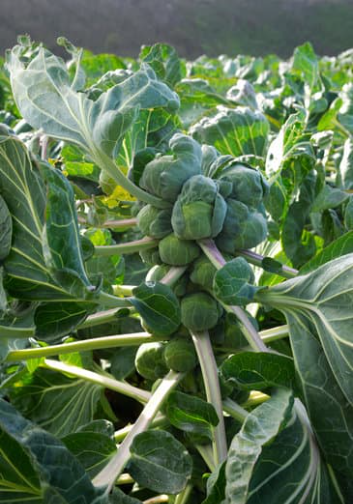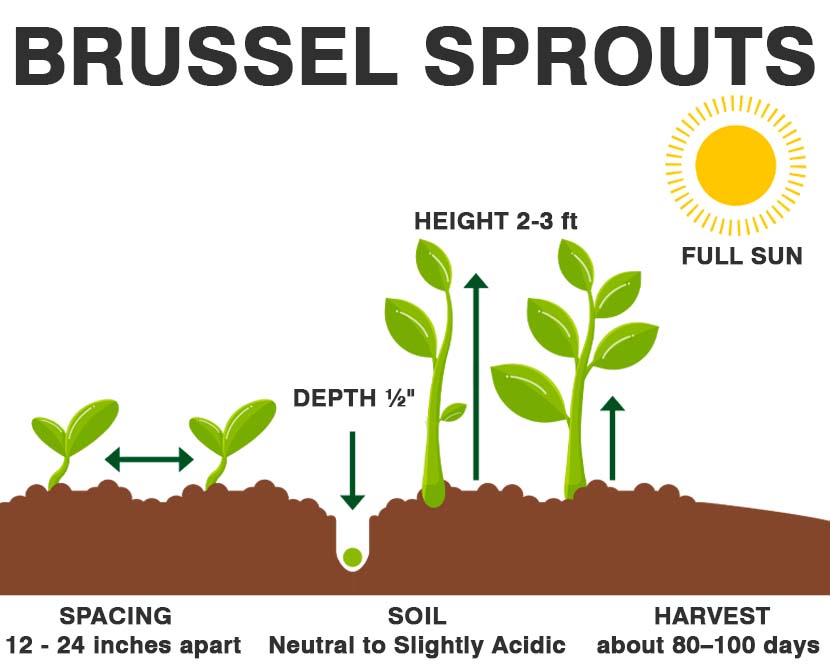Although Brussels sprouts (Brassica oleracea var. gemmifera) date back to ancient Rome, they’re named for the city of Brussels, Belgium, where they have been enjoyed for centuries. Part of the cabbage family, Brussels sprouts look like mini cabbage heads. They form on thick stems, along with broad leaves. These leaves are also edible and can be prepared like other hardy greens.
Brussels sprouts are slow-growing biennials (though commonly grown as annuals) that require a long growing season. They are typically planted in the summer for a fall to winter harvest.

| Common Name | Brussels sprouts |
| Botanical Name | Brassica oleracea var. gemmifera |
| Family | Brassicaceae |
| Plant Type | Biennial, annual, vegetable |
| Size | 2–3 ft. tall, 1 ft. wide |
| Sun Exposure | Full sun |
| Soil Type | Loamy, well-drained |
| Soil pH | Neutral |
| Bloom Time | Summer |
| Hardiness Zones | 2–10 (USDA) |
| Native Area | Mediterranean |

When to Plant?
This will be determined by your planting zone. There is a final frost date for each area. As a result, you can plan your gardening activities around this date. Check our Frost Dates Across North America: First & Last Frost Dates Chart. However, the date will not be the same for every plant.
How to Plant
Brussels sprouts grow best in cool weather, but they will sprout from seed when soil temperatures are between 45 and 80 degrees. If you do choose to grow from seed, direct-sow into the garden in mid to late summer for a fall harvest. Plant seedlings in the garden 6-10 weeks before the first expected frost. In zones 9-10, sow seeds or plant transplants October through December. Gardeners in cooler areas can grow a spring crop if they plant them outside as soon as the soil is workable.

Brussels sprouts thrive in full sun, and in rich, consistently moist soil. Because Brussels sprouts and other plants in the cabbage family (such as kale, collards, or broccoli) are susceptible to such a wide range of soil-borne diseases, it’s a good idea to rotate among various areas of the garden each season. Don’t plant Brussels sprouts where you last grew anything in the cabbage family.
Sow seeds one-fourth to one-half inch deep, 4 inches apart in rows or in raised beds. It takes seeds up to a week to sprout. Thin seedlings to 1-2 foot spacing after they have two sets of leaves. Space them 18 to 24 inches apart in the garden. Water thoroughly after planting, then add 2-3 inches of mulch around the base of each plant to help the soil retain moisture and keep weeds down by blocking access to the sun.
It is not necessary to stake Brussels sprouts at the time of planting. If you find that maturing plants are getting top-heavy and prone to flopping over, stake each plant individually with a thick bamboo stake, wooden stake, or piece of rebar and a loose piece of twine.
How to Cultivate
Brussels sprouts perform best in full sun, meaning at least six hours of direct sunlight on most days. Too much shade will slow the sprouts’ maturityю Brussels sprouts like a loamy, well-drained soil that’s rich in organic matter. It’s ideal to mix a thick layer of compost into the soil prior to planting. The soil pH should hover around neutral.
Keep the sprouts’ soil moist but not soggy. Around 1 to 1.5 inches of water per week should be sufficient. Inconsistent watering can result in poor sprout development. A layer of mulch can help to retain soil moisture and keep the roots cool. Use an organic vegetable fertilizer that’s high in nitrogen starting once the seedlings reach around 6 inches tall. Reapply throughout the growing season, following label instructions.
How to Harvest
Brussels sprouts grow tall first and don’t start producing sprouts until they reach almost full height. Each sprout grows in the leaf axil, or joint. Sprouts begin maturing from the bottom of the plant upward. Start harvesting when the lower sprouts reach about an inch in diameter. Pick them before they get too large and start cracking and turning bitter. Each plant yields approximately a quart of sprouts.
Pulling off the sprouts is easier if you remove the leaf below each sprout first. Then, twist and pull the sprout. Some people prefer to use pruners instead. After harvesting, a second crop of sprouts might begin to grow at the base of the stem. These won’t be as tight as the first crop, but they are still edible.
You can store sprouts in the refrigerator for around five days. Don’t wash them until right before you plan to use them.
Hydroponics
Germination: Start by germinating your Brussel sprouts seeds. You can do this by placing them in a moist paper towel or using a seed starting tray. Once the seeds have sprouted, transfer them to your hydroponic system.
pH range: Brussel sprouts prefer a pH range of 6.0-7.5. You can use a pH meter or test kit to monitor and adjust the pH level of your hydroponic solution.
EC: The recommended electrical conductivity (EC) for Brussel sprouts is between 1.6 and 2.2 mS/cm. This measures the total dissolved salts in the hydroponic solution, so it’s important to monitor it regularly and adjust as needed.
PPM: The parts per million (PPM) for Brussel sprouts is between 1120-1540. This measures the concentration of nutrients in the hydroponic solution, so it’s important to monitor it regularly and adjust as needed.
Humidity: Brussel sprouts prefer a humidity level between 50-60%. Use a hygrometer to monitor and adjust the humidity level in your growing area as needed.
Light hours: Brussel sprouts require at least 6 hours of direct sunlight per day. If you’re growing them indoors, you can use grow lights to provide the necessary light.
Temperature air: The optimal temperature range for Brussel sprouts is between 60-70°F (15-21°C). It’s important to maintain a consistent temperature in your growing area to ensure healthy growth.
Temperature water: The water temperature should be kept between 65-75°F (18-24°C) to promote healthy root growth and nutrient uptake.
With these guidelines, you should be able to successfully grow Brussel sprouts hydroponically. Good luck!



